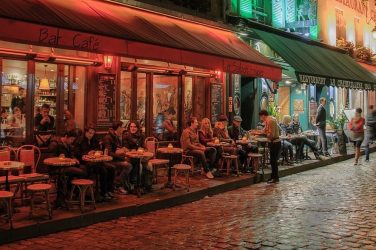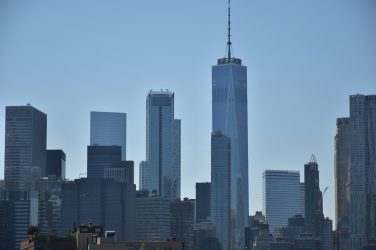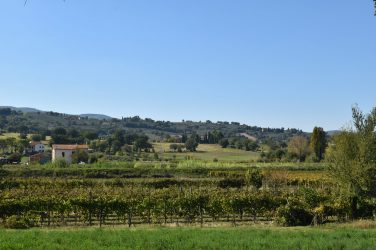Finnish Karelia, a region in Eastern Finland, has for long had an established tourism industry that has benefitted from the proximity of Russia and its affluent tourists crossing the border. However, nearly a year ago, the Russo-Ukrainian war led Finland to close its border to Russian tourists. To point out the collateral damages of the closed border to Karelia, E&M editor, and author Maria Taskinen, with her family roots in the region, takes us there on a visit.
“FOR RENT – free 88 square meter business space. Inquiries from this number.” That is written on a white A4 sheet taped on an empty shop space. I am in the center of Lappeenranta, a southeastern city in Finland, 30 kilometers from the Russian border.
It has been nearly a year since the Finnish government announced the closure of its border to Russian tourists. In early September 2022, Finland cut the number of tourist visas issued to Russians by 90 percent and followed the development with full border closure at the end of the month. The border would stay closed to Russians traveling to Finland for tourism or transit purposes “until further notice”.
The inflow of Russians was seen as a risk endangering Finland’s international relations, and consequently, the decision of closure was reached in the aftermath of the conversations with Ukraine. However, in eastern Finland, namely in Finnish Karelia, the decision, in many ways, has deepened the region’s distress.
Eastern Finland, has for longer been doing more poorly than other areas in the country. The region has suffered from higher unemployment rates, youth unemployment, morbidity, and a weaker dependency ratio. Population forecast is decreasing faster than elsewhere, and poverty among families with children is common. Also, business investment has shied away from the area and focused more on the southern and western parts of the country, and in general, there are fewer university places offered in the region.
The inflow of Russians was seen as a risk endangering Finland’s international relations, and consequently, the decision of closure was reached in the aftermath of the conversations with Ukraine. However, in eastern Finland, namely in Finnish Karelia, the decision, in many ways, has deepened the region’s distress.
One of the area’s economic foundations and hope for the future has been tourism. The five-million populated metropolis of St Petersburg, with its affluent population, is nearby, and indeed, the Russian tourists have been a stable source of income for many businesses in the region. Several shopping centers and resorts were purposely created to provide for the needs of the customers coming to Finland from the East. Now the border is closed.
Lappeenranta, Southern Karelia’s center for tourism and the second most visited city for Russian tourists in Finland (after Helsinki), is a dear place for me. My parents were born there, and most of my extended family still lives there. During my life, I have spent countless holidays in the city visiting my relatives and grandparents. The Russian signs in supermarkets, Russian tourist buses in the city center, and Russian menus in restaurants have been the norm.
Once again, this summer, I took the familiar 2-hour train from Helsinki to Lappeenranta to visit the city and my grandmother. This time, I wanted to find out more about how the lack of Russian tourists has impacted the city. Let’s start with a coffee table discussion in my grandmother’s apartment.
My 84-year-old grandmother. Has lived in Lappeenranta for 84 years.
“Mummi (Finnish word for grandmother), what do you think about the lack of Russian tourists this summer? Do you notice it?”
“Of course I notice it. The city is much calmer, and there is more space in supermarkets to do groceries. That is a nice thing. But for the city and the businesses here, it is a terribly bad thing. So many small shops and boutiques have had to shut down their business for good now.”
“Would you prefer to have the Russian tourists back?”
“That’s a difficult question; the war messes up one’s thinking. It would feel repulsive to have the tourists back, even though the situation here is not good. It is also true that not everyone crossing the border support the war. But for now, I think it is better like this.”
Empty market in the Lappeenranta harbor.
Indeed, the lack of tourists is distinguishable when visiting the city center. The commonly lively marketplace in the city’s harbor is nearly empty on a sunny July Saturday. I stop to talk with a girl selling strawberries.
“Yes, it has been different. The change started happening already during Covid, but especially this summer, you can see that most of the tourists are from southern Europe, and there are only a few Russians. Earlier in this job, knowledge of Russian would have been a crucial requirement for anyone applying, but now it is not as important. You simply don’t need the language as much.”
Empty market. Strawberry stall.
The lack of Russian tourists is costly for the region. The Russian invasion of Ukraine has been estimated to cost around 10 million euros for the South Karelia region every day – that’s how much has been lost from the regular tourism industry. As an area that already has suffered economically, the consequences of the war have meant a wave of bankruptcies for local businesses.
One example is a travel company, Saimaa Travel, which for 30 years has organized cruises between Lappeenranta and Vyborg. For all these years, the cruise ship used by the company, M/S Carelia, has been an iconic landmark in the Lappeenranta harbor and has brought hundreds of tourists on board to enjoy the canal-crossing experience on the Saimaa canal on the Finnish-Russian border.
However, early this year, Saimaa Travel ended up going bankrupt. The closure of the border during the pandemic, followed by the war, was too difficult for the travel company to continue its activity, and now the M/S Carelia is parked quietly in the harbor. Once a vibrant summer boat, is now only a memory.
Quiet M/S Carelia in the Lappeenranta harbor.
A short stroll around the city center repeats the same story. I quickly have counted all my fingers when identifying empty business spaces.
It is both fascinating and scary to think how the proximity to the Russian border, which once meant a steady flow of tourists and income, has now turned to suffocate most of the area’s economic activity by merely existing so close.
Seeing eastern Finland struggling makes me sad, not least due to the family attachment I have with the region. Finnish Karelia and its people have a strong cultural heritage, and with hundreds of lakes (including Lake Saimaa), the area provides one of the most picturesque lake landscapes in the whole country. It is both fascinating and scary to think how the proximity to the Russian border, which once meant a steady flow of tourists and income, has now turned to suffocate most of the area’s economic activity by merely existing so close.
The city of Lappeenranta has planned to turn M/S Carelia into a summer terrace restaurant. In July, the tables were still empty.
In a classic Karelian spirit, the locals stay positive about the future. While the war has stopped Russian tourists from entering Finland, many Finnish tourists have been interested in visiting the border region this summer. Also, foreign tourists scared off by Russia have been reported to have made their return to the eastern border after Finland’s joining NATO a few months ago – especially Americans.
The same optimism is told to me in Lappeenranta harbor. I ask a ticket vendor of another cruise ship, next to M/S Carelia, sailing only on Lake Saimaa, about the number of foreign tourists this summer.
“How is the situation with the international tourists? Has the war impacted their amount?”
“Not that much! We have received a lot of bookings from especially German, American and Japanese tourists. Of course less Russians, but otherwise, it really has been fine.”
It is true that no matter what the future of Karelia actually holds, the area’s geographic position will always make it an intriguing place to visit. The position also ensures that for defense purposes, the area should not be left to decay or crumble economically. Therefore, I want to remain positive (or maybe it is my Karelian blood) and believe in a better future for the region.
With this, I want to invite everyone traveling to Finland to go and discover Karelia. You will not only enjoy the landscapes, but you will also help people and an area that, passively, has also taken its hit from this war. <3.
All photos by the author.
















Show Comments